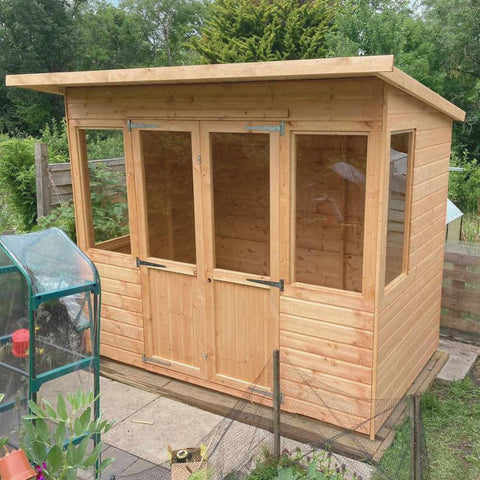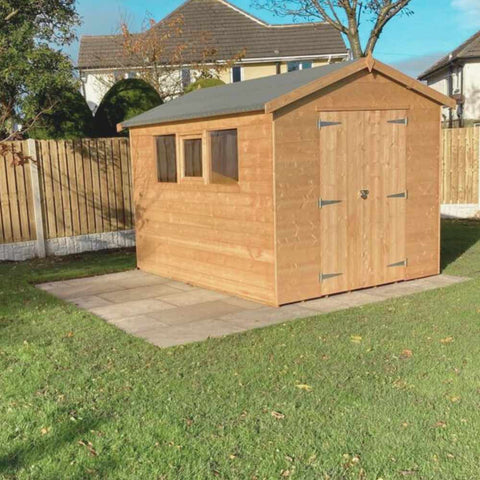Understanding Your Garden Shed Needs
A garden shed is more than just a storage space. It's a vital part of your garden's landscape, a hub for your gardening activities, and a shelter for your tools and equipment.
Choosing the perfect garden shed, however, is not a task to be taken lightly.
It requires careful consideration of various factors, from the shed's design and materials to its size and placement. But one aspect that often gets overlooked is maintenance.
Maintenance is key to ensuring your garden shed stands the test of time. It helps protect your investment, keeping your shed in top condition year after year.
In this comprehensive guide, we delve into the world of garden sheds. We explore how to choose the perfect shed with maintenance in mind.
We'll discuss the importance of understanding your shed needs. We'll talk about assessing space and size requirements, and defining the purpose of your shed.
We'll explore the pros and cons of different shed materials. We'll discuss how weather conditions can impact your choice of materials and the longevity of your shed.
We'll delve into shed design and aesthetics. We'll talk about how to choose a shed that not only serves its purpose but also complements your garden.
We'll discuss practical features for functionality and security. We'll explore door types, ventilation, insulation, and lighting considerations.
We'll also cover the legal considerations and installation tips. We'll guide you through navigating building codes and regulations, and what to expect from professional installation versus DIY.
Whether you're a homeowner, a gardening enthusiast, or a DIY individual, this guide is for you.
Join us as we uncover the secrets to choosing the perfect garden shed, with a focus on long-term maintenance and satisfaction.
Top Tips
Before you start browsing for garden sheds, it's crucial to understand your specific needs. This understanding forms the foundation of your decision-making process.
Firstly, consider the space available in your garden. This will dictate the size of the shed you can accommodate.
Secondly, think about what you plan to store in the shed. This will influence the design and layout of your shed.
Lastly, consider your maintenance capabilities. Different materials and designs require different levels of upkeep.
Assessing Space and Size Requirements
The size of your garden shed is largely determined by the space available in your garden. It's important to measure this space accurately.
Remember to leave enough room around the shed for easy access. This is especially important for maintenance tasks like painting or repairing the shed.
The size of your shed will also depend on what you plan to store inside. Larger items like lawnmowers or bicycles will require more space.
Consider future storage needs as well. You might acquire more tools or equipment over time.

Defining the Purpose of Your Shed
The purpose of your shed is another crucial factor to consider. A shed can serve various purposes, from a simple storage space to a workshop or hobby room.
If you plan to use your shed as a workspace, consider factors like lighting and ventilation.
For a storage shed, consider the type and quantity of items you plan to store. This will influence the design and layout of your shed.
Remember, a well-defined purpose will guide you in choosing a shed that meets your needs and is easy to maintain.
Shed Design and Aesthetics: Complementing Your Garden
The design of your garden shed should not only be functional but also aesthetically pleasing. It should complement your garden's overall design and enhance its beauty.
Consider the shed's shape and style. There are many designs to choose from, including traditional, modern, and rustic styles.
The color of your shed is also important. It should blend well with your garden's color scheme.
Consider also the shed's placement in your garden. It should be easily accessible but not obstruct the view of your garden.
Lastly, consider the shed's size in relation to your garden. It should not overpower your garden or make it feel cramped.

Roofing and Foundation Choices
The choice of roofing and foundation for your garden shed is crucial. These elements play a significant role in the shed's durability and maintenance needs.
For roofing, consider materials that are durable and weather-resistant. All our sheds come with optional upgrade to a higher quality shed felt.
The roof's design is also important. A sloping roof, for example, allows rainwater to run off easily, reducing the risk of leaks.
For the foundation, consider materials that are sturdy and resistant to moisture. Concrete, gravel, and wood are common choices.
A well-chosen roof and foundation will not only enhance your shed's durability but also reduce its maintenance needs.
Customization and Aesthetic Appeal
Customizing your garden shed can enhance its aesthetic appeal and functionality. There are many ways to customize your shed to suit your needs and tastes.
Consider adding windows for natural light and ventilation. Choose a door that is wide enough for your largest tools and equipment.
You can also add shelves, hooks, and racks for storage. This will help keep your shed organized and make it easier to find what you need.
Consider also the exterior of your shed. You can add flower boxes, a trellis, or other decorative elements to enhance its beauty.
Remember, a well-designed and aesthetically pleasing shed can enhance your garden's beauty and increase your property's value.
Practical Features for Functionality and Security
When choosing a garden shed, practical features are key. These features enhance the shed's functionality and security, ensuring it meets your needs and protects your belongings.
Consider the shed's layout. It should allow for easy movement and storage of your tools and equipment.
The shed's doors and windows should also be functional. They should open and close easily and provide adequate ventilation.
Security features are also important. Locks, alarms, and sturdy doors can help protect your shed from theft and vandalism.
Lastly, consider the shed's lighting. Good lighting can make your shed more usable and safer, additional windows can help create more light.

Door Types, Placement, and Security Measures
The type and placement of your shed's doors can greatly affect its functionality and security. There are several factors to consider when choosing a door for your shed.
First, consider the door's size. It should be wide enough to accommodate your largest tools and equipment.
Second, consider the door's placement. It should allow for easy access to your shed and not obstruct the pathway.
Third, consider the door's security features. A sturdy door with a good lock can help protect your shed from theft.
Each one of our sheds can have the door located in a variety of positions and can also be hung in different ways to enable opening in different directions.
Lastly, as an additional upgrade we can offer increased security features for each door.
Ventilation, Insulation, and Lighting Considerations
Proper ventilation, insulation, and lighting can greatly enhance your shed's usability and comfort. These features can also help protect your shed and its contents from damage.
Ventilation is important for preventing mould and mildew. Consider adding vents or windows to your shed to allow for air circulation. This is an optional extra we offer.
Insulation can make your shed usable year-round. It can help keep your shed warm in winter and cool in summer.
Lighting is crucial for safety and usability. Consider adding both natural and artificial lighting to your shed.
Remember, a well-ventilated, insulated, and well-lit shed can make your gardening tasks more enjoyable and efficient.
Maintenance and Upkeep: Ensuring Long-Term Satisfaction
Maintenance and upkeep are crucial for the longevity of your garden shed. Regular maintenance can prevent damage, extend the shed's lifespan, and ensure your satisfaction in the long term.
Consider the maintenance needs of your shed's finish. If the shed is tanalised or dip treated it will still require annual maintenance and weather protection. We sell in store and on the website various wood treatment and protection.
Regular inspections are also important. They can help you spot and address issues before they become major problems.
Preventative care is another key aspect of shed maintenance. This includes tasks like sealing, painting, and cleaning your shed.
Lastly, consider the impact of weather and pests on your shed. Proper weatherproofing and pest control strategies can protect your shed and its contents.
We also recommend installing a shed away from any trees that can grow into the shed and damage it, but also any foliage that drops onto the shed can cause issues.
Regular Inspections and Preventative Care
Regular inspections and preventative care can greatly extend the lifespan of your garden shed. These practices can help you spot and address issues early, preventing costly repairs down the line.
Inspect your shed regularly for signs of damage. Look for issues like leaks, rot, rust, and structural damage.
Preventative care is also crucial. This includes tasks like sealing, painting, and cleaning your shed.
Remember, a well-maintained shed is more durable, functional, and aesthetically pleasing. Regular inspections and preventative care can ensure your shed remains in good condition for years to come.
We stock a wide range of Shed Repair Products
Pest Control and Weatherproofing Strategies
Pests and weather can cause significant damage to your garden shed. However, with proper strategies, you can protect your shed and its contents.
Pest control is crucial for preventing damage and infestations. Regular cleaning, sealing gaps, and using pest repellents can help keep pests at bay.
Weatherproofing is also important. This includes tasks like sealing, insulating, and using weather-resistant materials.
Remember, a well-protected shed can withstand harsh weather and pests, ensuring its longevity and functionality.
Navigating Building Codes and Regulations
Understanding local building codes and regulations is crucial when installing a garden shed. These rules can dictate various aspects of your shed, including its placement, size, and design.
Check with your local council or building authority for specific regulations. These may include rules about shed height, distance from property lines, and foundation requirements.
Non-compliance with these regulations can result in fines or even the need to remove or modify your shed. Therefore, it's important to understand and follow these rules from the start.
Remember, a legally compliant shed is a long-term investment that can enhance your property without causing legal issues.
Professional Installation vs. DIY: What to Expect
When it comes to installing your garden shed, you have two main options: professional installation or a DIY approach. Each has its own advantages and considerations.
Professional installation can ensure your shed is installed correctly and efficiently. This option can save you time and effort, but it can also be more expensive.
On the other hand, a DIY approach can be more cost-effective. However, it requires more time, effort, and potentially some skill.
Remember, the best installation method for you depends on your budget, skills, and time availability.
Our installation service will give you peace of mind however all self installation choices come with instruction manuals.
View our more detailed explanation on our shed installation service
Conclusion: Making an Informed Decision
Choosing the perfect garden shed involves careful consideration of various factors. These include your specific needs, the shed's materials and design, practical features, maintenance requirements, and legal considerations.
By taking the time to make an informed decision, you can ensure your garden shed not only enhances your outdoor space but also serves its purpose effectively for years to come.
Visit our full shed range to see the different designs we offer. Our service also means we can offer and shape or size needed .. to get a bespoke quotation please out a contact form and someone will be back in contact
If you need some inspiration ? Visit our shed install gallery



